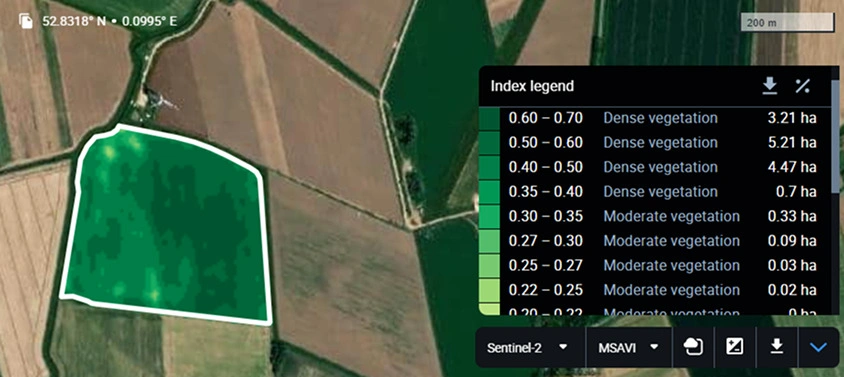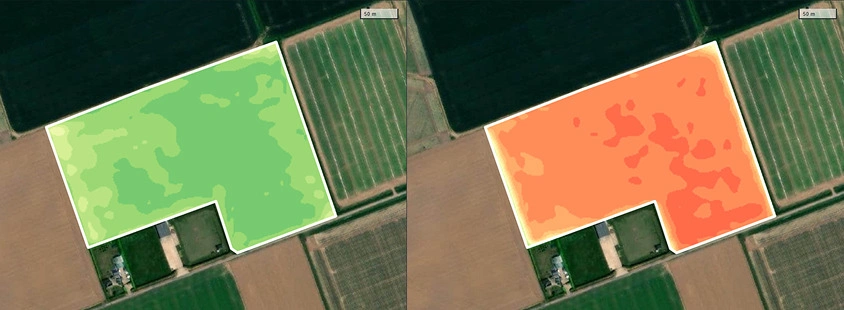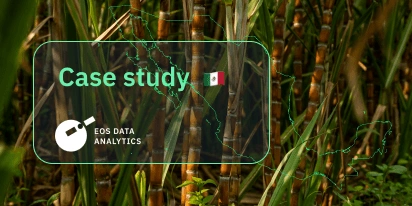
UK Farming Cooperative Uses SatTech To Optimize Harvest
British farmers grow peas on over 61,000 hectares of land, which makes the UK one of Europe’s main pea producers . However, the crop is particularly susceptible to heat and drought stress, severely impacting yield stability. Increasingly hot weather has challenged the agricultural sector’s ability to forecast and maintain crop quality.
A UK farming cooperative with more than 45 members has been growing peas since the early 1970s. The company supplies both freezing and canning factories, which means they need to accurately target different areas across their fields for each purpose. As weather patterns became increasingly harsh and unpredictable, they needed a better way to forecast yields and plan harvesting.
The company turned to EOSDA Crop Monitoring for help. By using satellite and weather data from the platform, they can now optimize their harvest plans to supply different markets. This helps our client’s company maintain high quality standards even when weather conditions aren’t ideal.
| Challenge | A pea farming cooperative needed accurate satellite and weather data to optimize harvesting on over 5.6 thousand acres in the United Kingdom. |
| Solution | The company used vegetation indices, weather data, and the Scouting app to better target harvesting areas with peas for different intended uses. |
| Outcome | A UK pea farming cooperative improved harvest management and produce quality with the help of EOSDA Crop Monitoring. |
Overview: About The Client
Our client’s company is a well-established farming cooperative with over 45 members focused on growing premium vining peas for the freezing and canning markets. Known for its efficient harvesting and logistics processes, it ensures all their peas for Greenyard Frozen (a major European frozen vegetable producer) are frozen just within 150 minutes after harvest to lock in freshness and nutritional value.
Operating for over half a century, the cooperative company has earned a strong reputation for adaptability in the agricultural sector. It combines traditional farming values with modern, innovative agricultural technologies to remain a market leader.
Quality and sustainability are central to the company’s mission. With a focus on soil conservation and responsible resource management, the company delivers top-grade produce to partners while protecting the environment for future generations.
Challenge: Efficient Harvest Planning Amid Weather Uncertainties
Despite its robust operations, our client’s company faces increasing challenges due to extreme weather. Sudden heavy rains, unexpected heatwaves, and prolonged droughts have become more common in recent years. Inconsistent weather conditions lead to uneven crop maturity, which complicates the decision-making process on when and where to harvest.
The need to supply both freezing and canning factories complicates the company’s challenges. They must carefully allocate crops grown on multiple fields to the right processing facilities to maximize returns. However, relying on visual assessments and traditional methods makes it difficult to target specific areas with superior crop quality for particular uses. The company had to harvest whole fields without previously differentiating peas between different factories. This made them look for more effective ways to harvest based on the intended use of the peas.
Solution: Vegetation Indices, Weather Data, And Scouting App
To harvest peas efficiently for different markets, the UK farming cooperative adopted vegetation indices on EOSDA Crop Monitoring. A major advantage was the ability to integrate the platform’s NDRE (Normalized Difference Red Edge Index) data into the company’s custom yield prediction models. This allowed them to divide fields into distinct zones, targeting the best areas to harvest for either freezing or canning factories.
One of the key challenges in using vegetation indices during later growth stages is the decline in chlorophyll content, which can cause NDRE and NDVI to provide misleading readings. As plants ripen and start to wither, exposed soil further skews the data. MSAVI was applied to counter this, validating NDRE-based modeling results.


Additionally, the Split view feature on EOSDA Crop Monitoring allows the client’s team to compare vegetation maps for different dates side-by-side. By observing how vegetation density and vigor changed over time, they could better predict ripening trends and optimize their harvest schedules.

Weather data analytics available on EOSDA Crop Monitoring allowed the client’s company to address the uncertainties caused by sudden weather changes. By accessing accurate site-specific weather forecasts for up to 14 days directly on the platform, they were able to better plan harvest schedules, avoiding potential damage from heavy rains, droughts, and other extreme weather events. This proactivity helped the company stabilize operations and reach higher-quality harvests despite fluctuating weather patterns.
EOSDA’s mobile Scouting app was another valuable tool. The field team used it to monitor and properly handle areas affected by pests or poor soil conditions. Having this data on hand enabled them to adjust harvesting operations, focusing their efforts on healthier zones to maintain high crop quality.
We’ve been using EOSDA Crop Monitoring for around five years, and it’s become a crucial tool for our operations. By downloading EOSDA’s satellite data and integrating it into our yield prediction model, we’ve significantly improved our ability to target harvest areas precisely. This has helped us optimize harvesting operations and deliver better-quality peas to specific factories.
Outcome: Improved Harvest Efficiency And Agility
Since adopting EOSDA Crop Monitoring, our client has experienced tangible improvements in yield forecasting and harvest operations. By incorporating vegetation index data into their prediction model, they achieved more accurate insights, which supported better planning and resource allocation. Targeting specific areas during harvest has ensured that only best-quality peas are sent to the appropriate factories. Additionally, the weather analytics on the platform strengthened the company’s ability to adapt to challenging weather conditions.
The precise and agile approach to harvesting backed by EOSDA Crop Monitoring has increased the company’s efficiency and contributed to higher-quality produce being delivered to market. With this helpful platform in place, the company is well-positioned to achieve more predictable harvests, better resource management, and consistent product quality.
About the author:
Maksym Sushchuk is at the forefront of realizing EOSDA's vision to make space tech a global driver of sustainability on Earth. He has over 15 years of experience in journalism and content creation for prominent Ukrainian startups, charitable funds and ESG businesses. As Head and Co-founder of PR Army Maxim brings attention to the human and social tolls of the aggression against Ukraine.
Recent articles

Analyze 2025 & Plan Your Best Year Yet: LandViewer Christmas Offer
It’s the most wonderful time of the year! The Christmas holidays are here, and so is your chance to analyze 2025 and plan a prosperous 2026 with more affordable Pro plans in LandViewer.

EOSDA Models Climate Change Impact On Sugarcane Yields
EOSDA modeled future temperature, rainfall, and other climate impacts on Veracruz sugarcane. The results help growers plan long-term adaptation strategies, including timing, varieties, and irrigation.

EOSDA LandViewer Black Friday Sale: Exclusive Offers & Giveaway
This Black Friday, LandViewer offers new users the chance to save on monthly plans, get extra months with yearly subscriptions, and participate in a free annual plan giveaway.